Soft Pneumatic Muscles: Revolutionizing Human Assistive Devices with Geometric Design and Intelligent Control
Abstract
1. Introduction
2. Advancements in Soft Pneumatic Muscles
3. Upper Limb Assistive Device
4. Model Design
5. Finite Element Analysis FEA and Material Characterization
5.1. Characterization of Material
5.2. Finite Element Analysis FEA
6. Workspace and Kinematic Model for SPM
6.1. Workspace of Soft Pneumatic Muscles
6.2. Forward and Inverse Kinematic Modeling by ANN
7. Conclusions
Author Contributions
Funding
Conflicts of Interest
References
- Whitesides, G. Soft Robotics. Angew. Chem. Int. Ed. 2018, 57, 4258–4273. [Google Scholar] [CrossRef] [PubMed]
- Belforte, G.; Eula, G.; Ivanov, A.; Sirolli, S. Soft Pneumatic Actuators for Rehabilitation. Actuators 2014, 3, 84–106. [Google Scholar] [CrossRef]
- Joe, S.; Totaro, M.; Wang, H.; Beccai, L. Development of the Ultralight Hybrid Pneumatic Artificial Muscle: Modelling and optimization. PLoS ONE 2021, 16, e0250325. [Google Scholar] [CrossRef] [PubMed]
- Su, H.; Hou, X.; Zhang, X.; Qi, W.; Cai, S.; Xiong, X.; Guo, J. Pneumatic Soft Robots: Challenges and Benefits. Actuators 2022, 11, 92. [Google Scholar] [CrossRef]
- Albu-Schaffer, A.; Eiberger, O.; Grebenstein, M.; Haddadin, S.; Ott, C.; Wimbock, T.; Wolf, S.; Hirzinger, G. Soft robotics. IEEE Robot. Autom. Mag. 2008, 15, 20–30. [Google Scholar] [CrossRef]
- Kalita, B.; Leonessa, A.; Dwivedy, S. A Review on the Development of Pneumatic Artificial Muscle Actuators: Force Model and Application. Actuators 2022, 11, 288. [Google Scholar] [CrossRef]
- Lorenzon, L.; Beccali, G.; Maselli, M.; Cianchetti, M. A Self-sensing Inverse Pneumatic Artificial Muscle. In Proceedings of the 2022 IEEE 5th International Conference on Soft Robotics (RoboSoft), Edinburgh, UK, 4–8 April 2022; pp. 817–822. [Google Scholar]
- Soliman, M.; Saleh, M.; Mousa, M.; Elsamanty, M.; Radwan, A. Theoretical and experimental investigation study of data driven work envelope modelling for 3D printed soft pneumatic actuators. Sens. Actuators A Phys. 2021, 331, 112978. [Google Scholar] [CrossRef]
- Youssef, S.; Soliman, M.; Saleh, M.; Mousa, M.; Elsamanty, M.; Radwan, A. Modeling of Soft Pneumatic Actuators with Different Orientation Angles Using Echo State Networks for Irregular Time Series Data. Micromachines 2022, 13, 216. [Google Scholar] [CrossRef]
- Feng, N.; Chang, Y.; Wang, S.; Zhao, Z. A variable stiffness composite mixed with pneumatic muscle fibers and elastomer. Mech. Adv. Mater. Struct. 2020, 29, 1821–1829. [Google Scholar] [CrossRef]
- Han, K.; Kim, N.; Shin, D. A Novel Soft Pneumatic Artificial Muscle with High-Contraction Ratio. Soft Robot. 2018, 5, 554–566. [Google Scholar] [CrossRef]
- Elsamanty, M.; Fanni, M.; Ramadan, A. Novel hybrid ground/aerial autonomous robot. In Proceedings of the 2012 First International Conference on Innovative Engineering Systems, Alexandria, Egypt, 7–9 December 2012; pp. 103–108. [Google Scholar]
- Elsamanty, M.; Fanni, M.; Ramadan, A.; Abo-Ismail, A. Modeling and control of a novel Hybrid Ground Aerial Robot. In Proceedings of the 2013 IEEE International Conference on Mechatronics and Automation, Takamatsu, Japan, 4–7 August 2013; pp. 1559–1565. [Google Scholar]
- Kim, W.; Park, H.; Kim, J. Compact Flat Fabric Pneumatic Artificial Muscle (ffPAM) for Soft Wearable Robotic Devices. IEEE Robot. Autom. Lett. 2021, 6, 2603–2610. [Google Scholar] [CrossRef]
- Hashem, R.; Stommel, M.; Cheng, L.; Xu, W. Design and Characterization of a Bellows-Driven Soft Pneumatic Actuator. IEEE/ASME Trans. Mechatron. 2021, 26, 2327–2338. [Google Scholar] [CrossRef]
- Hong, T.; Park, S.; Park, J.; Paik, N.; Park, Y. Design of Pneumatic Origami Muscle Actuators (POMAs) for A Soft Robotic Hand Orthosis for Grasping Assistance. In Proceedings of the 2020 3rd IEEE International Conference On Soft Robotics (RoboSoft), New Haven, CT, USA, 15 May–15 July 2020; pp. 627–632. [Google Scholar]
- Zhang, W.; Qin, L.; Wang, J.; Xu, W. Design of squeezing-tube-driven pump for soft pneumatic robotics based on spiral spring winding. Appl. Phys. Lett. 2023, 122, 093702. [Google Scholar] [CrossRef]
- Chen, Y.; Wang, L.; Galloway, K.; Godage, I.; Simaan, N.; Barth, E. Modal-Based Kinematics and Contact Detection of Soft Robots. Soft Robot. 2021, 8, 298–309. [Google Scholar] [CrossRef]
- Drotman, D.; Ishida, M.; Jadhav, S.; Tolley, M. Application-Driven Design of Soft, 3-D Printed, Pneumatic Actuators with Bellows. IEEE/ASME Trans. Mechatron. 2019, 24, 78–87. [Google Scholar] [CrossRef]
- Yap, Y.; Sing, S.; Yeong, W. A review of 3D printing processes and materials for soft robotics. Rapid Prototyp. J. 2020, 26, 1345–1361. [Google Scholar] [CrossRef]
- Elango, N.; Faudzi, A. A review article: Investigations on soft materials for soft robot manipulations. Int. J. Adv. Manuf. Technol. 2015, 80, 1027–1037. [Google Scholar] [CrossRef]
- Alphonse, A.; Abbas, A.; Fathy, A.; Elsayed, N.; Ammar, H.; Elsamanty, M. Modelling of Continuum Robotic Arm Using Artificial Neural Network (ANN). In Proceedings of the 2019 Novel Intelligent and Leading Emerging Sciences Conference (NILES), Giza, Egypt, 28–30 October 2019; Volume 1, pp. 191–195. [Google Scholar]
- Case, J.; White, E.; Kramer, R. Soft Material Characterization for Robotic Applications. Soft Robot. 2015, 2, 80–87. [Google Scholar] [CrossRef]
- Polygerinos, P.; Wang, Z.; Overvelde, J.; Galloway, K.; Wood, R.; Bertoldi, K.; Walsh, C. Modeling of Soft Fiber-Reinforced Bending Actuators. IEEE Trans. Robot. 2015, 31, 778–789. [Google Scholar] [CrossRef]
- Zhang, S.; Gong, D.; Yu, J. Design of a Multi-connection Pneumatic Artificial Muscle. In Proceedings of the 2022 12th International Conference on CYBER Technology in Automation, Control, and Intelligent Systems (CYBER), Baishan, China, 27–31 July 2022; pp. 301–306. [Google Scholar]
- Manns, M.; Morales, J.; Frohn, P. Additive manufacturing of silicon based PneuNets as soft robotic actuators. Procedia CIRP 2018, 72, 328–333. [Google Scholar] [CrossRef]
- Schmitt, F.; Piccin, O.; Barbé, L.; Bayle, B. Soft Robots Manufacturing: A Review. Front. Robot. AI 2018, 5, 84. [Google Scholar] [CrossRef] [PubMed]
- Chou, C.; Hannaford, B. Measurement and modeling of McKibben pneumatic artificial muscles. IEEE Trans. Robot. Autom. 1996, 12, 90–102. [Google Scholar] [CrossRef]
- Kim, S.; Laschi, C.; Trimmer, B. Soft robotics: A bioinspired evolution in robotics. Trends Biotechnol. 2013, 31, 287–294. [Google Scholar] [CrossRef] [PubMed]
- Polygerinos, P.; Wang, Z.; Galloway, K.; Wood, R.; Walsh, C. Soft robotic glove for combined assistance and at-home rehabilitation. Robot. Auton. Syst. 2015, 73, 135–143. [Google Scholar] [CrossRef]
- Pan, M.; Yuan, C.; Liang, X.; Dong, T.; Liu, T.; Zhang, J.; Zou, J.; Yang, H.; Bowen, C. Soft Actuators and Robotic Devices for Rehabilitation and Assistance. Adv. Intell. Syst. 2022, 4, 2100140. [Google Scholar] [CrossRef]
- Saleh, M.; Soliman, M.; Mousa, M.; Elsamanty, M. Gripping Force Modeling of a Variable Inclined Air Pillow Soft Pneumatic Actuator. In Proceedings of the 2020 2nd Novel Intelligent and Leading Emerging Sciences Conference (NILES), Giza, Egypt, 24–26 October 2020; pp. 219–223. [Google Scholar]
- Nassour, J.; Zhao, G.; Grimmer, M. Soft pneumatic elbow exoskeleton reduces the muscle activity, metabolic cost and fatigue during holding and carrying of loads. Sci. Rep. 2021, 11, 12556. [Google Scholar] [CrossRef]
- Guan, Q.; Sun, J.; Liu, Y.; Wereley, N.; Leng, J. Novel Bending and Helical Extensile/Contractile Pneumatic Artificial Muscles Inspired by Elephant Trunk. Soft Robot. 2020, 7, 597–614. [Google Scholar] [CrossRef]
- Tawk, C.; In het Panhuis, M.; Spinks, G.; Alici, G. Bioinspired 3D Printable Soft Vacuum Actuators for Locomotion Robots, Grippers and Artificial Muscles. Soft Robot. 2018, 5, 685–694. [Google Scholar] [CrossRef]
- Tsai, T.; Chiang, M. Design and Control of a 1-DOF Robotic Lower-Limb System Driven by Novel Single Pneumatic Artificial Muscle. Appl. Sci. 2020, 10, 43. [Google Scholar] [CrossRef]
- Xavier, M.; Tawk, C.; Zolfagharian, A.; Pinskier, J.; Howard, D.; Young, T.; Lai, J.; Harrison, S.; Yong, Y.; Bodaghi, M.; et al. Soft Pneumatic Actuators: A Review of Design, Fabrication, Modeling, Sensing, Control and Applications. IEEE Access 2022, 10, 59442–59485. [Google Scholar] [CrossRef]
- Tawk, C.; Alici, G. A Review of 3D-Printable Soft Pneumatic Actuators and Sensors: Research Challenges and Opportunities. Adv. Intell. Syst. 2021, 3, 2000223. [Google Scholar] [CrossRef]
- Kim, S.; Lee, S.; Lee, S.; Lee, D.; Shin, D. Power-Efficient Soft Pneumatic Actuator Using Spring-Frame Collateral Compression Mechanism. Actuators 2022, 11, 76. [Google Scholar] [CrossRef]
- Saga, N.; Shimada, K.; Inamori, D.; Saito, N.; Satoh, T.; Nagase, J.Y. Smart Pneumatic Artificial Muscle Using a Bend Sensor like a Human Muscle with a Muscle Spindle. Sensors 2022, 22, 8975. [Google Scholar] [CrossRef]
- Liu, J.; Ma, Z.; Wang, Y.; Zuo, S. Reconfigurable Self-Sensing Pneumatic Artificial Muscle with Locking Ability Based on Modular Multi-Chamber Soft Actuator. IEEE Robot. Autom. Lett. 2022, 7, 8635–8642. [Google Scholar] [CrossRef]
- Hu, X.; Luo, C.; Li, H.; Jia, L.; Song, C.; Wang, Z.; Qu, X. An Ankle Based Soft Active Orthotic Device Powered by Pneumatic Artificial Muscle. In Proceedings of the 2019 IEEE International Conference on Real-time Computing and Robotics (RCAR), Irkutsk, Russia, 4–9 August 2019; pp. 374–378. [Google Scholar]
- Lin, Z.; Shao, Q.; Liu, X.; Zhao, H. An Anthropomorphic Musculoskeletal System with Soft Joint and Multifilament Pneumatic Artificial Muscles. Adv. Intell. Syst. 2022, 4, 2200126. [Google Scholar] [CrossRef]
- Huang, J.; Cao, Y.; Xiong, C.; Zhang, H. An Echo State Gaussian Process-Based Nonlinear Model Predictive Control for Pneumatic Muscle Actuators. IEEE Trans. Autom. Sci. Eng. 2019, 16, 1071–1084. [Google Scholar] [CrossRef]
- Mao, Z.; Iizuka, T.; Maeda, S. Bidirectional electrohydrodynamic pump with high symmetrical performance and its application to a tube actuator. Sens. Actuators A Phys. 2021, 332, 113168. [Google Scholar] [CrossRef]
- Mao, Z.; Asai, Y.; Yamanoi, A.; Seki, Y.; Wiranata, A.; Minaminosono, A. Fluidic rolling robot using voltage-driven oscillating liquid. Smart Mater. Struct. 2022, 31, 105006. [Google Scholar] [CrossRef]
- Elkholy, H.A.; Shahin, A.S.; Shaarawy, A.W.; Marzouk, H.; Elsamanty, M. Solving Inverse Kinematics of a 7-DOF Manipulator Using Convolutional Neural Network. In Proceedings of the International Conference on Artificial Intelligence and Computer Vision (AICV2020), Cairo, Egypt, 8–10 April 2020; Volume 1153, pp. 219–223. [Google Scholar]
- Marcee, A.; Treadway, E. Self-Powered Microgravity Resistance Exercise with Soft Pneumatic Exoskeletons. In Proceedings of the 2022 IEEE Aerospace Conference (AERO), Big Sky, MT, USA, 5–12 March 2022; pp. 1–10. [Google Scholar]
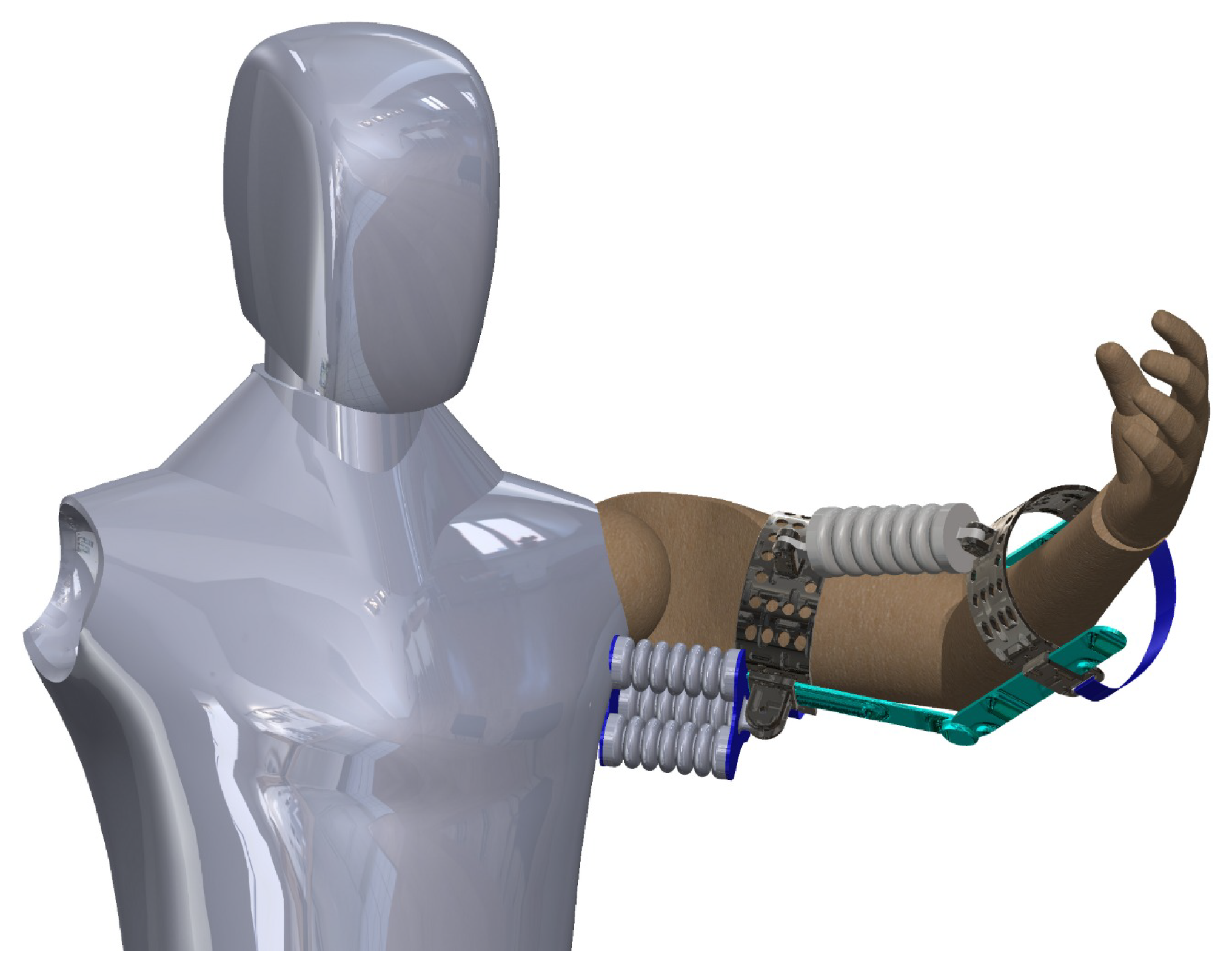
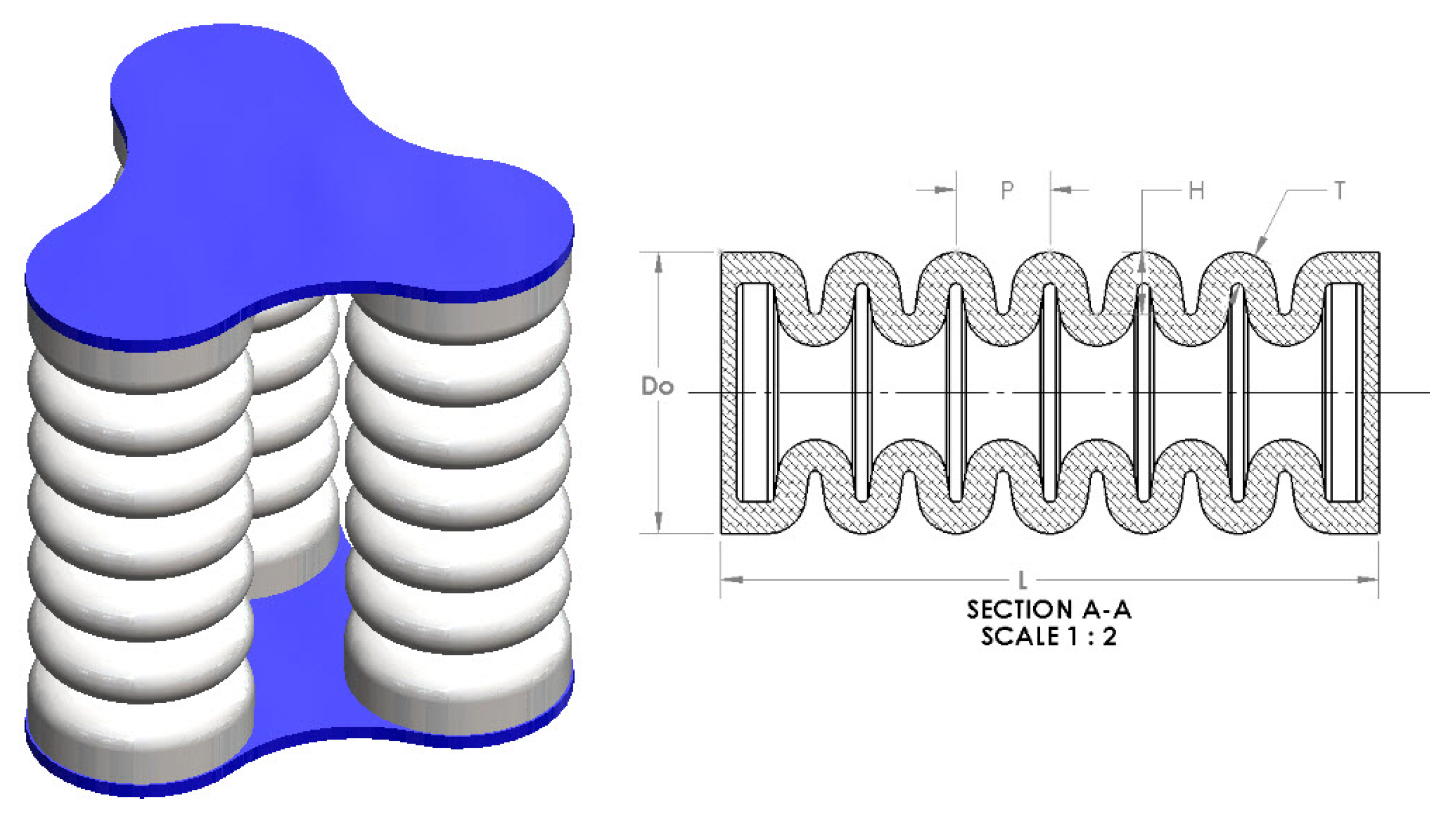
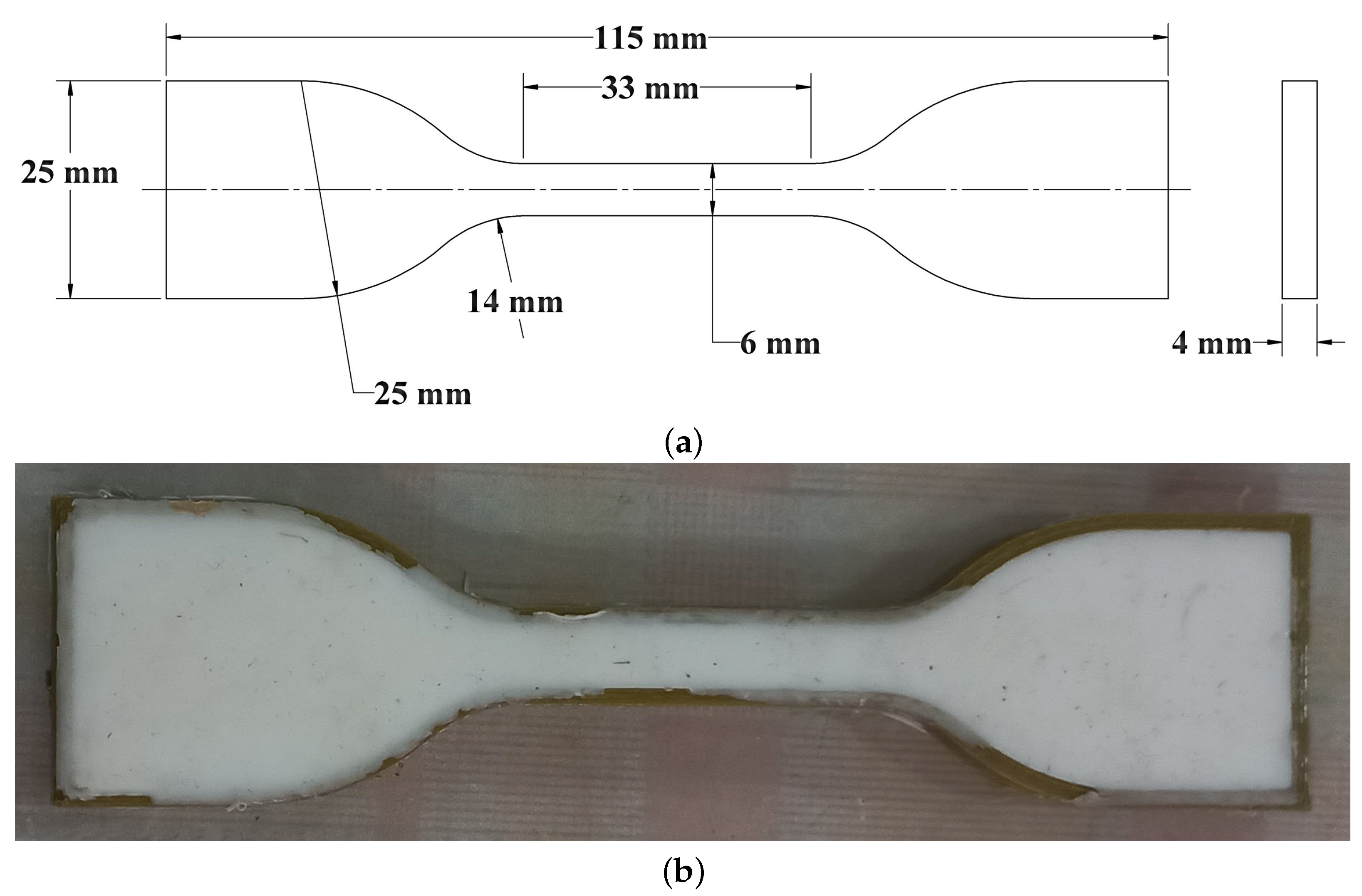

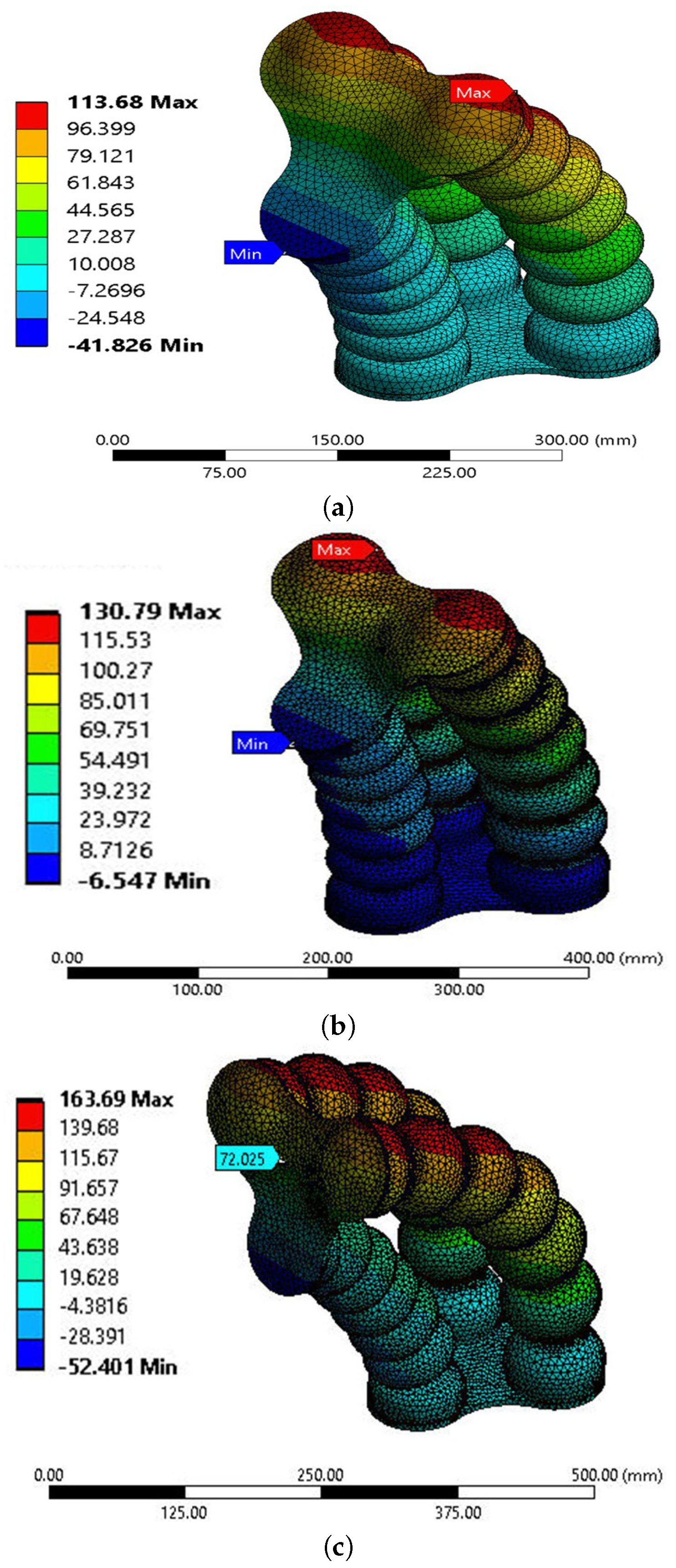

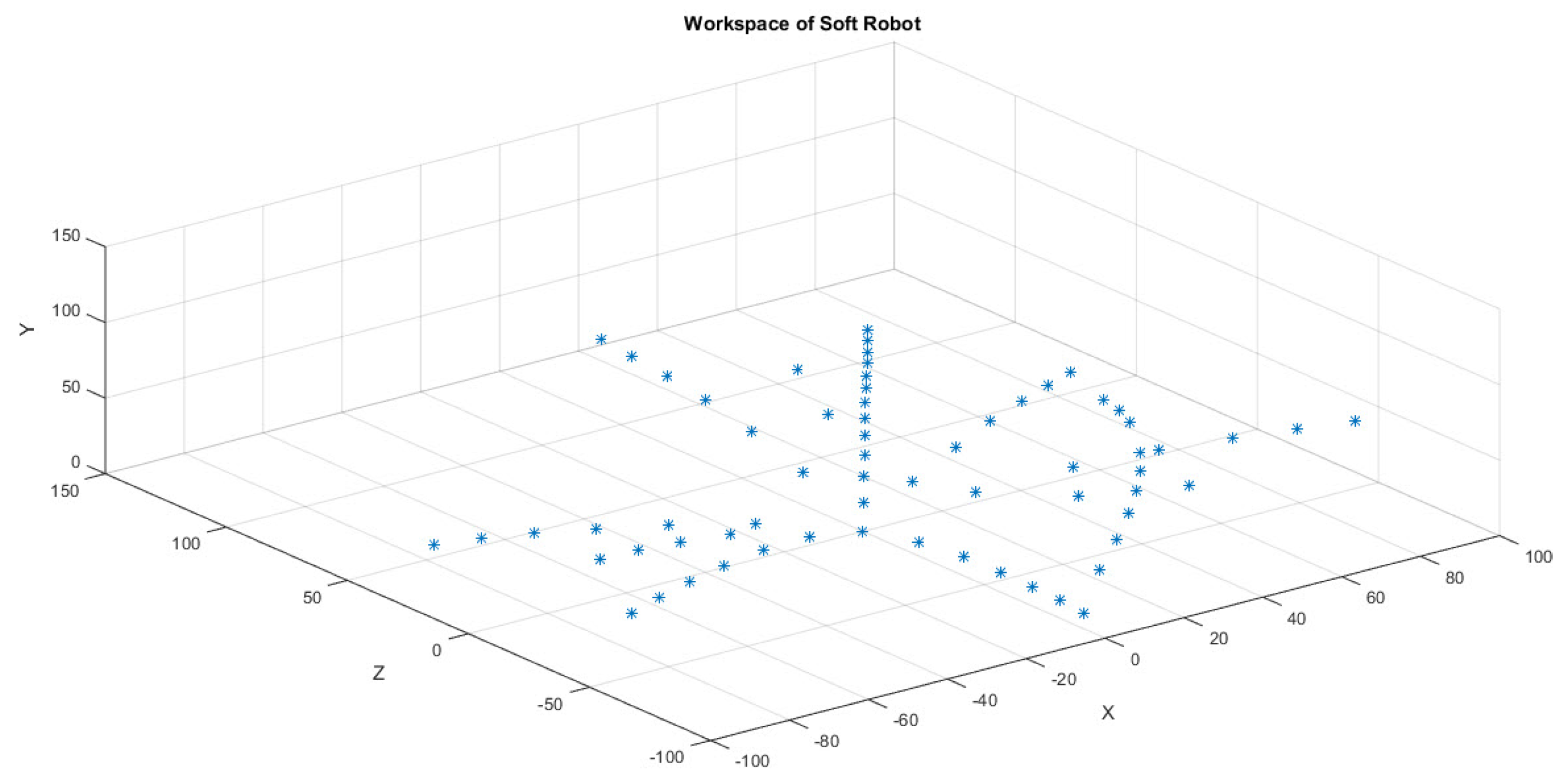

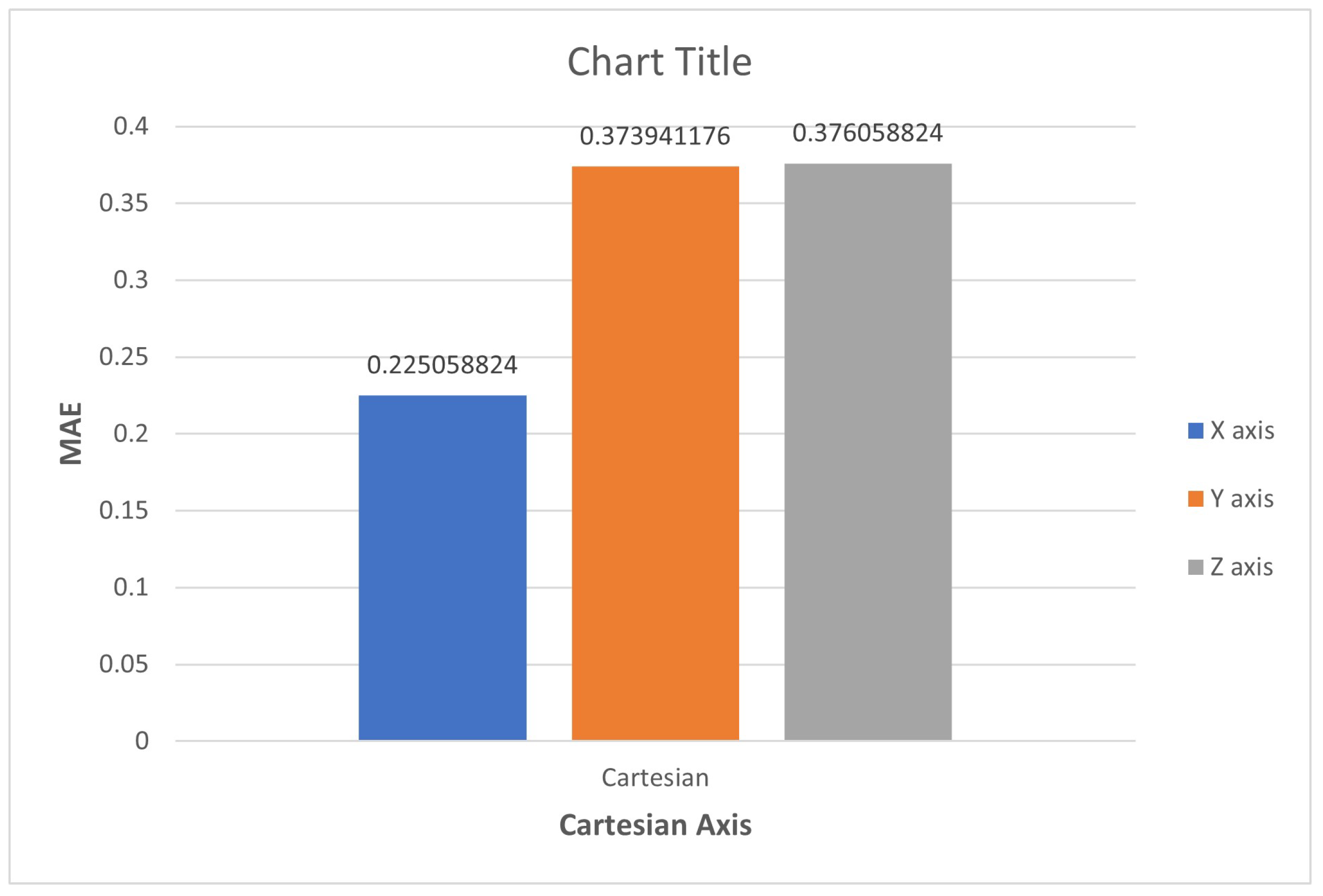
| Parameters | L | T | H | P | |
|---|---|---|---|---|---|
| Values | 210 mm | 90 mm | 7 mm | 20 mm | 30 to 38 mm |
| Description | Value |
|---|---|
| Silicon Rubber Density | 1080 kg/m3 |
| 0.196259775 MPa | |
| 0.009010431 MPa | |
| −0.000105654 MPa |
Disclaimer/Publisher’s Note: The statements, opinions and data contained in all publications are solely those of the individual author(s) and contributor(s) and not of MDPI and/or the editor(s). MDPI and/or the editor(s) disclaim responsibility for any injury to people or property resulting from any ideas, methods, instructions or products referred to in the content. |
© 2023 by the authors. Licensee MDPI, Basel, Switzerland. This article is an open access article distributed under the terms and conditions of the Creative Commons Attribution (CC BY) license (https://creativecommons.org/licenses/by/4.0/).
Share and Cite
Elsamanty, M.; Hassaan, M.A.; Orban, M.; Guo, K.; Yang, H.; Abdrabbo, S.; Selmy, M. Soft Pneumatic Muscles: Revolutionizing Human Assistive Devices with Geometric Design and Intelligent Control. Micromachines 2023, 14, 1431. https://doi.org/10.3390/mi14071431
Elsamanty M, Hassaan MA, Orban M, Guo K, Yang H, Abdrabbo S, Selmy M. Soft Pneumatic Muscles: Revolutionizing Human Assistive Devices with Geometric Design and Intelligent Control. Micromachines. 2023; 14(7):1431. https://doi.org/10.3390/mi14071431
Chicago/Turabian StyleElsamanty, Mahmoud, Mohamed A. Hassaan, Mostafa Orban, Kai Guo, Hongbo Yang, Saber Abdrabbo, and Mohamed Selmy. 2023. "Soft Pneumatic Muscles: Revolutionizing Human Assistive Devices with Geometric Design and Intelligent Control" Micromachines 14, no. 7: 1431. https://doi.org/10.3390/mi14071431
APA StyleElsamanty, M., Hassaan, M. A., Orban, M., Guo, K., Yang, H., Abdrabbo, S., & Selmy, M. (2023). Soft Pneumatic Muscles: Revolutionizing Human Assistive Devices with Geometric Design and Intelligent Control. Micromachines, 14(7), 1431. https://doi.org/10.3390/mi14071431











